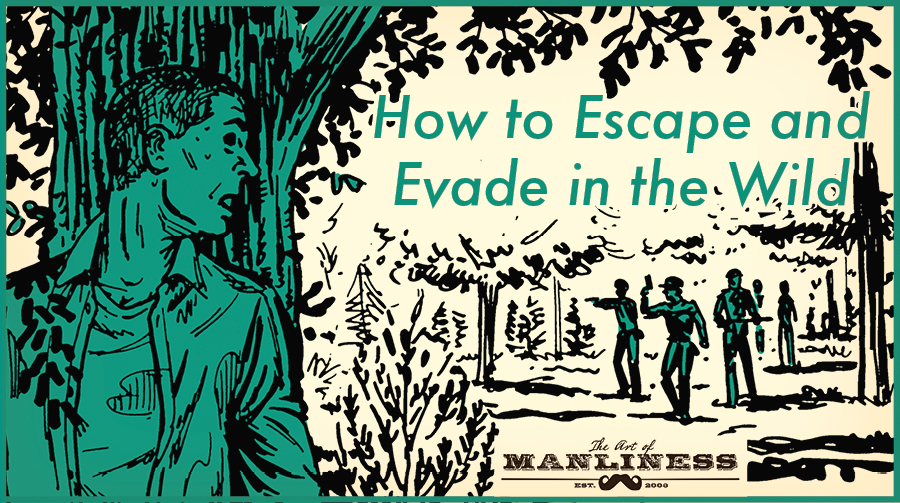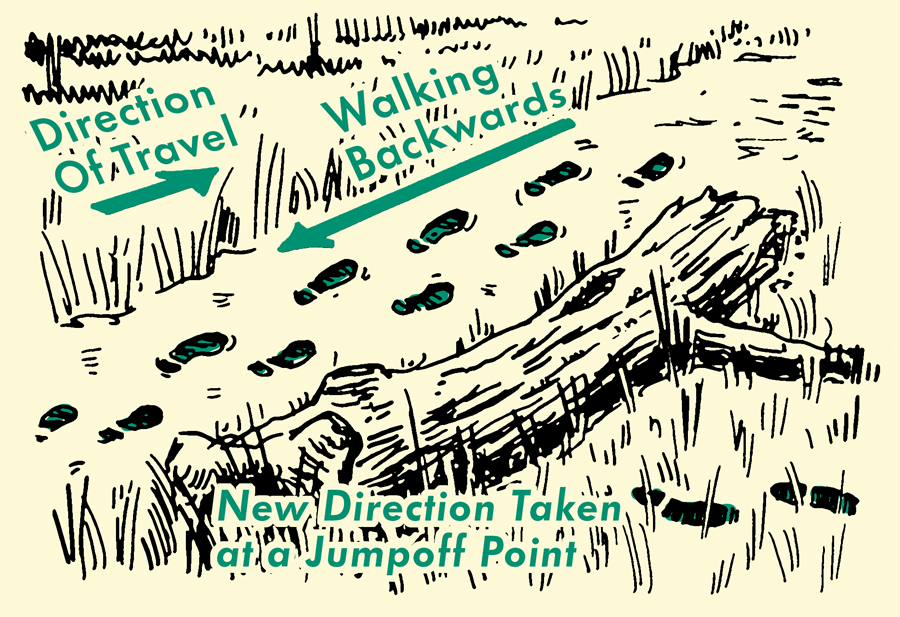
A few years ago we published an article on how to track a human in the wild. But what do you do if the shoe is on the other foot, and you’re the one being hunted?
If for whatever reason you find yourself evading a band of marauding outlaws in some dystopian future, you’ll want to implement counter-tracking measures to evade them.
Even if you never end up being the one pursued (and I hope you never do because that means something has gone terribly wrong in your life), understanding counter-tracking measures will make you a better tracker as you’ll know what to look for in targets trying to evade your pursuit.
You Can Run, But It’s Really Difficult to Hide
The ultimate goal of counter-tracking is to evade your enemy and get to safety.
But understand that a talented tracker knows the counter-tracking measures you might use and will still likely be able to find you.
In real life manhunts through the wilderness, the hunted is almost invariably found. If the fugitive is wily, it might take a few days longer before he’s captured, but he’ll ultimately be nabbed.
Exceptions exist, of course, like the clever hermit who managed to live in the Maine woods, and commit 1,000 burglaries, while avoiding detection and the searches of law enforcement for almost 30 years. In general, though, the old saying is true, “You can run, but you can’t hide.” When you’re dealing with seasoned, dedicated trackers, counter-measures will at best probably only give you a little extra time on the lam.
Of course, you may not be pursued by expert trackers — marauding bands of baby-eating barbarians are often rank amateurs in this department. In which case the following counter-tracking measures may accomplish the goal of helping you make a clean getaway. They can be broken down into three main categories: leaving no trace, staying out of sight, and employing deception.
1. Leave No (or as Little) Trace as Possible
In our article about tracking a human, we highlighted several indicators that trackers use to find their target. When you’re the one being pursued, you have to reverse-engineer them, so to speak; you have to know what not to leave behind to avoid tipping off the tracker to your trail.
Don’t leave detritus behind. If you’re escaping and evading, be extremely conscious of not leaving behind any discarded objects. Food wrappers, clothing, and gum are just a few of the things a tracker will be looking for. Be especially cognizant of unintentionally discarded items — sometimes when you pull your hands out of your pockets, stuff comes out with them.
Don’t leave your biological waste behind. Trackers will also be looking for biological evidence of your presence, specifically blood, feces, and urine. If you’re bleeding, make sure you’re bandaged, so you don’t leave a trail. When you take a wiz or a dump, make sure to cover it up when you’re done. Of course, covering up your waste creates evidence of a ground disturbance (more on that in a bit), which a seasoned tracker will be looking for, too. Do your best to make your cat hole look as natural as possible.
Avoid “honeypots.” Expert tracker John Hurth calls soft, impressionable areas of ground that readily capture tracks “honeypots” because they leave so much information behind. Mud, sand, soft dirt, and snow are examples of honeypots. Long grass can also be a honeypot because the tracker will be able to see the trampled, bent grass that you walked through. Avoid honeypots and do your best to stick to hard, rocky surfaces.
If you’re escaping and evading in snow or in a sandy desert, avoiding honeypots will be difficult, but it is possible to minimize the trace you leave behind. If you’re evading on snow-covered ground, try to move only when new snow is actually falling from the sky. The falling snow plus the wind will erase your tracks. Same thing for sandy environments. Try to travel when the wind is blowing so that your tracks are blown away.
Avoid disturbing the environment. Besides looking for footprints, a tracker will also be looking for disturbances in the environment. If you’re walking in a wooded area with lots of leaves or pine needles on the ground, you won’t leave much in terms of footprints, but if you’re not careful, you’ll still leave behind evidence in the form of snapped twigs and overturned leaves.
Besides disturbances on the ground, trackers will be looking for aerial disturbances like broken cobwebs and broken tree branches. If there’s a cobweb between trees, go under it or around it. As you pass by low-hanging tree limbs, try not to bend or break them. Make sure clothing or other items don’t get hung up in tree branches. Also avoid scuffing trees.
Keep a low auditory profile. Trackers will not only be looking for visual indicators, but listening for auditory ones. So be as quiet as possible. Move like a ninja.
Don’t be smelly. A tracker will use all of his senses, including his nose, to find you. The smell of smoke can lead trackers to you, so avoid making fires if possible. Lotions, soaps, food, and body odor also give off scents that can reveal your presence.
2. Stay Out of Sight
Besides being aware of the traces you leave behind, to successfully evade a pursuer you quite naturally don’t want them to see you!
But here’s the rub: moving objects are easier to spot than stationary ones.
So how do you keep moving without being seen?
Here are a few tips drawn from Army field manual FM 21-76: Survival, Evasion, and Recovery.
Camouflage yourself. Unless you’re wearing camo, you’ll need to use your surroundings as a natural disguise. Survival expert Creek Stewart gave a pretty detailed tutorial on how to do this a few years ago — you essentially plaster yourself with mud and leaves. Keep in mind that when you collect materials for your camouflage, you don’t want to get them all from the same location. That will just create a big disturbance in the environment, clearly indicating your trail.
Camouflaging is a bit trickier in snow and desert environments. You don’t have that much flora and fauna to use to conceal yourself. Do your best with what you’ve got.
Move when visibility is lowest. If you don’t want your pursuers to see you, only move when visibility is low: nighttime, stormy weather, dust storms, snow storms, etc.

Avoid silhouetting. Silhouetting occurs when you move in front of the skyline at night. There’s just enough light to create a silhouette of your profile, making you stick out like a sore thumb. To avoid silhouetting, stay off of ridges and the tops of hills. When you move, stay low to the ground, making sure there’s something in your background (like trees) besides the sky.
Use natural cover. As you move, stay close to natural cover like trees, shrubs, and bushes. This may require low crawling. As you stay close to natural cover, be cognizant of not disturbing things too much. First rule of evasion: don’t leave a trace!
3. Deception Practices
No matter how much you work to hide your tracks, you’re still going to leave them. To evade your pursuers, you’ll need to implement some deception tactics to throw them off your trail.
Again, expert trackers know these deception techniques and will consequently be on the lookout for signs of them. While, at best, they’ll simply slow an expert pursuer down, they could throw an amateur entirely off your trail.
Walk backwards. A common deception tactic is to walk backwards. When you do so, the prints of your feet point in one direction, but you’re moving in the opposite direction. If it works, your pursuers will follow the route your toes point towards.
The problem with this deception technique is that a good tracker can detect it by looking at your footprints: a shortened stride and a more pronounced and deeper imprint on the heel give the ruse away.
They’ll also be looking for which direction gravel and dirt are being dragged in relation to the print. If you’re walking backwards, the dirt will be dragged in the direction you’re actually walking, not the direction you’re trying to make them think you’re walking.

Brush away your tracks. If you’re walking on ground that leaves footprints, you can brush them away as you walk to hide your trail. This could be done by rigging a piece of carpet or a leaf-covered branch around your waist, so it drags behind you, sweeping away your footprints as you walk.
Of course, this tactic can be noticed by a well-trained tracker. For example, they’ll likely notice the outline of the edges of the carpet that you’re dragging along.
Walking in a stream. Running water will allow you to walk without leaving footprints, as the moving water will erase whatever prints you may leave in the stream or river bed.
Be aware that honeypots exist near stream beds. The mud that you’ll encounter as you enter and exit a stream will readily capture your tracks.

Doubling back. Doubling back is when you walk and leave a trail in a general direction, but then walk backward over your track to a jump-off point. If all goes according to plan, your trackers will follow your initial line of tracks and bypass your jump-off point.
Unseasoned trackers will eventually realize you’ve doubled back when they reach the point where your prints suddenly stop. Seasoned trackers will likely figure it out earlier by seeing the dirt that’s being pushed backward on your forward-facing prints, indicating that you’re walking backward on your tracks. The other issue with doubling back is that if you don’t walk perfectly backward over your footprints, you’ll just leave another set of prints behind. But the technique, done well, can buy you some extra time.
As you can see above, evading a tracker is hard. Damn hard. But with a bit of cleverness and a lot of luck, you just might be able to successfully escape and evade those who hunt the most dangerous game.
________________________
Sources:







